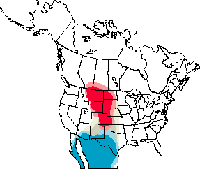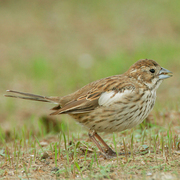Lark Bunting
Calamospiza
melanocorys
Passeriformes
Members of this diverse group make up more than half of the bird species worldwide. Most are small. However their brains are relatively large and their learning abilities are greater than those of most other birds. Passerine birds are divided into two suborders, the suboscines and the oscines. Oscines are capable of more complex song, and are considered the true songbirds. In Washington, the tyrant flycatchers are the only suboscines; the remaining 27 families are oscines.
Emberizidae
The Emberizidae family is made up of the New World sparrows, longspurs, and some of the buntings. Most forage and nest on the ground. Most emberizids are seedeaters and have short, thick bills adapted for this diet, although they all eat insects and other arthropods at times, and feed them to their young. They are typically monogamous. Females generally build the nests and incubate the eggs and young, but both parents feed the young. Clutches are small, generally three to five eggs. Many of these birds are small, brown, and streaked, and stay close to cover, making identification challenging.
General Description
Casual spring and fall migrant, mostly in southeastern Washington or along the coasts.
North American Range Map


Family Members
 Green-tailed TowheePipilo chlorurus
Green-tailed TowheePipilo chlorurus Spotted TowheePipilo maculatus
Spotted TowheePipilo maculatus American Tree SparrowSpizella arborea
American Tree SparrowSpizella arborea Chipping SparrowSpizella passerina
Chipping SparrowSpizella passerina Clay-colored SparrowSpizella pallida
Clay-colored SparrowSpizella pallida Brewer's SparrowSpizella breweri
Brewer's SparrowSpizella breweri Vesper SparrowPooecetes gramineus
Vesper SparrowPooecetes gramineus Lark SparrowChondestes grammacus
Lark SparrowChondestes grammacus Black-throated SparrowAmphispiza bilineata
Black-throated SparrowAmphispiza bilineata Sage SparrowAmphispiza belli
Sage SparrowAmphispiza belli Lark BuntingCalamospiza melanocorys
Lark BuntingCalamospiza melanocorys Savannah SparrowPasserculus sandwichensis
Savannah SparrowPasserculus sandwichensis Grasshopper SparrowAmmodramus savannarum
Grasshopper SparrowAmmodramus savannarum Le Conte's SparrowAmmodramus leconteii
Le Conte's SparrowAmmodramus leconteii Nelson's Sharp-tailed SparrowAmmodramus nelsoni
Nelson's Sharp-tailed SparrowAmmodramus nelsoni Fox SparrowPasserella iliaca
Fox SparrowPasserella iliaca Song SparrowMelospiza melodia
Song SparrowMelospiza melodia Lincoln's SparrowMelospiza lincolnii
Lincoln's SparrowMelospiza lincolnii Swamp SparrowMelospiza georgiana
Swamp SparrowMelospiza georgiana White-throated SparrowZonotrichia albicollis
White-throated SparrowZonotrichia albicollis Harris's SparrowZonotrichia querula
Harris's SparrowZonotrichia querula White-crowned SparrowZonotrichia leucophrys
White-crowned SparrowZonotrichia leucophrys Golden-crowned SparrowZonotrichia atricapilla
Golden-crowned SparrowZonotrichia atricapilla Dark-eyed JuncoJunco hyemalis
Dark-eyed JuncoJunco hyemalis Lapland LongspurCalcarius lapponicus
Lapland LongspurCalcarius lapponicus Chestnut-collared LongspurCalcarius ornatus
Chestnut-collared LongspurCalcarius ornatus Rustic BuntingEmberiza rustica
Rustic BuntingEmberiza rustica Snow BuntingPlectrophenax nivalis
Snow BuntingPlectrophenax nivalis McKay's BuntingPlectrophenax hyperboreus
McKay's BuntingPlectrophenax hyperboreus

